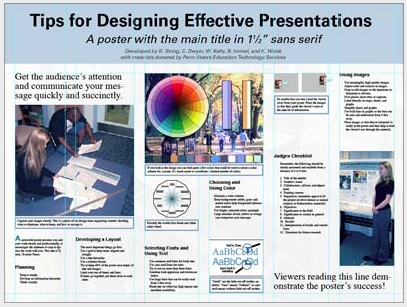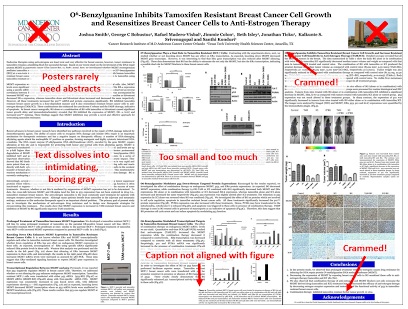What is a project poster?
Posters are widely used in the academic community, and most conferences include poster presentations in their program. Research posters summarize information or research concisely and attractively to help publicize it and generate discussion.
The poster is usually a mixture of a brief text mixed with tables, graphs, pictures, and other presentation formats. At a conference, the researcher stands by the poster display while other participants can come and view the presentation and interact with the author.
What makes a good poster?
- Read the poster session instructions of your specific session to presenters. If not provided ask for poster / board size in order to fully utilize the allowed space.
- For the CMPE 492 poster session, you may use A0 sized posters. The poster should be horizatally oriented as vertical posters will not fit the boards.
- Important information should be readable from about 10 feet away. Minimum recommended text sizes are: 85 pt font for the main title, 36 pt for subheadings, 24 pt for body text, and 18 pt for captions.
- Title should be short and it should draw interest
- Word count should be about 300 to 800 words
- Text should be clear and to the point
- Use of bullets, numbering, and headlines make your poster easy to read
- Effective use of graphics, color and fonts is important
- Use a consistent and clean layout
- To keep your poster looking neat and tidy, use gridlines. And if you don’t have an artistic eye, consider working with a template.
- Include acknowledgments, your name, your advisors and institutional affiliation.
- Bogazici University Logos can be downloaded from http://www.boun.edu.tr/tr_TR/Content/Genel/Kurumsal_Kimlik. Please adhere to instituional use standarts.
Printing Guidelines?
- Before you print:
- Double check for spelling and grammar mistakes (ask a friend - a new set of eyes is more likely to catch errors).
- Make sure your poster is sized correctly and your images are not pixelated.
- Give yourself enough time to have your poster printed (and reprinted if you find a mistake). Don't wait until the last minute!
- Printing a poster may take up to 3 days depending on printer availablity at printing houses. Ask / plan ahead.
- Make sure your file is of adequate resolution and size to make a quality print (printing size must be set before you start your design!).
Where do I begin?
Before sitting in front of a computer, answer these three questions:
- What is the most important/interesting/astounding finding from my research project?
- How can I visually share my research with conference attendees? Should I use charts, graphs, tables, photos, images?
- What kind of information can I convey during my talk that will complement my poster?
What software can I use to make a poster?
PowerPoint: A popular, easy-to-use option. It is available for academic use from https://www.license.boun.edu.tr/ . (Advice for creating a poster with PowerPoint).
Latex / Beamer: Another popular choice, the beamer package of latex allows the creation of good looking posters. An easy to use editor with lots of templates can be found at this link: https://www.overleaf.com/gallery/tagged/poster
Adobe Illustrator, Photoshop and InDesign: Feature-rich professional software that is good for posters including lots of high-resolution images, but they are more complex and expensive.
Open Source Alternatives: OpenOffice in the free alternative to MS Office (Impress is its PowerPoint alternative). Inkscapeand Gimp are alternatives to Adobe products. For charts and diagrams try LucidChart or Gliffy. A complete list of free graphics software.
Copyright Concerns…
Copyright Concerns If you use images from the web, make sure you are not breaking copyright law. You can ask permission from the source or use images that are licensed as Creative Commons. In addition, government images usually fall in the public domain and are free from copyright.
Useful Links...
- A blog series from İsmail Arı, one of our former TA’s, on poster preparation:
- https://guides.nyu.edu/c.php?g=276826&p=1846154
- Free powerpoint templates: https://www.genigraphics.com/templates, https://www.makesigns.com/SciPosters_Templates.aspx,
http://www.posterpresentations.com/html/free_poster_templates.html, https://www.postersession.com/poster-templates.php
A sample of a well designed poster
Image credit: Poster Session Tips by mousejockey![]() psu.edu, via Penn State
psu.edu, via Penn State


